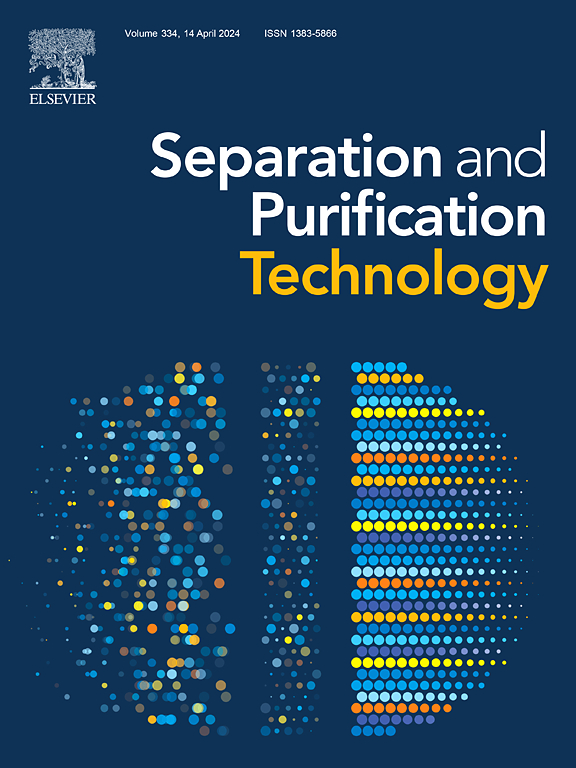无机薄膜的自限制界面合成用于高性能有机溶剂纳滤在制药中的应用
IF 8.1
1区 工程技术
Q1 ENGINEERING, CHEMICAL
引用次数: 0
摘要
无机膜由于其优异的耐溶剂性、机械强度和耐用性,是制药工业有机溶剂回收的主要候选者。然而,构建高性能的无机分离层仍然是有机溶剂纳滤(OSN)无机膜制备中最具挑战性的方面。普鲁士蓝类似物(PBAs)具有刚性立方结构,具有较强的共价金属氰化物配位键,具有较高的化学稳定性。受界面聚合(IP)策略的启发,本研究提出了一种基于K3[Fe(CN)6]和乙酰丙酮(如Cu(acac)2、Mn(acac)3或Co(acac)2)的配位反应在多孔陶瓷衬底上合成普鲁士蓝模拟薄膜(PBA TFs)的简单方法。Mn-Fe PBA膜具有高的溶剂渗透性(例如,乙酸乙酯为176.4 L·m−2·h−1·bar−1),并且在六种测试溶剂中显示分子量截止范围为665至760 Da。为了评价Mn-Fe - PBA膜的工业潜力,采用7种活性药物成分/溶剂体系在双级OSN系统中进行了溶剂回收实验。在tylosin/二甲亚砜体系中,Mn-Fe PBA膜的API保留率超过80% %,在多个循环中保持稳定的性能。通过调节单体扩散条件,分析了PBA TFs的形成过程。分子动力学模拟进一步阐明了膜的形成机理。IP策略的自限制性质不仅抑制了PBA大晶体的形成,而且诱导PBA纳米晶体沿正己烷/水界面自组装,从而形成完整的PBA TF。这种IP策略为高性能无机OSN膜的制备开辟了一条新的道路。本文章由计算机程序翻译,如有差异,请以英文原文为准。


Self-limiting interfacial synthesis of inorganic thin films for high-performance organic solvent nanofiltration in pharmaceutical applications
Inorganic membranes are prime candidates for organic solvent recovery in the pharmaceutical industry due to their excellent solvent resistance, mechanical strength and durability. However, constructing high-performance inorganic separation layers is still the most challenging aspect in the fabrication of inorganic membranes for organic solvent nanofiltration (OSN). Prussian blue analogues (PBAs) exhibit high chemical stability for their rigid cubic framework with strong covalent metal-cyanide coordination bonds. Inspired by the interfacial polymerization (IP) strategy, this study proposes a simple synthesis method for prussian blue analog thin films (PBA TFs) on porous ceramic substrates, using coordination reactions between K3[Fe(CN)6] and acetylacetonate (e.g. Cu(acac)2, Mn(acac)3 or Co(acac)2). The Mn-Fe PBA membrane exhibits high solvent permeance (e.g., 176.4 L·m−2·h−1·bar−1 for ethyl acetate) and demonstrates a molecular weight cut-off ranging from 665 to 760 Da across six tested solvents. To evaluate the industrial potential of Mn-Fe PBA membranes, solvent recovery experiments were conducted in a twin-stage OSN system using seven active pharmaceutical ingredient (API)/solvent systems. In the tylosin/dimethyl sulfoxide system, the Mn-Fe PBA membrane achieved over 80 % total API retention, maintaining stable performance across multiple cycles. The formation process of PBA TFs was analyzed by adjusting monomer diffusion conditions. Furthermore, molecular dynamics simulations elucidated the film formation mechanism. The self-limiting nature of the IP strategy not only inhibits the formation of PBA large crystals, but also induces the self-assembly of PBA nanocrystals along the n-hexane/water interface, resulting in a complete PBA TF. This IP strategy blazes a new trail for fabrication of high-performance inorganic OSN membranes.
求助全文
通过发布文献求助,成功后即可免费获取论文全文。
去求助
来源期刊

Separation and Purification Technology
工程技术-工程:化工
CiteScore
14.00
自引率
12.80%
发文量
2347
审稿时长
43 days
期刊介绍:
Separation and Purification Technology is a premier journal committed to sharing innovative methods for separation and purification in chemical and environmental engineering, encompassing both homogeneous solutions and heterogeneous mixtures. Our scope includes the separation and/or purification of liquids, vapors, and gases, as well as carbon capture and separation techniques. However, it's important to note that methods solely intended for analytical purposes are not within the scope of the journal. Additionally, disciplines such as soil science, polymer science, and metallurgy fall outside the purview of Separation and Purification Technology. Join us in advancing the field of separation and purification methods for sustainable solutions in chemical and environmental engineering.
 求助内容:
求助内容: 应助结果提醒方式:
应助结果提醒方式:


